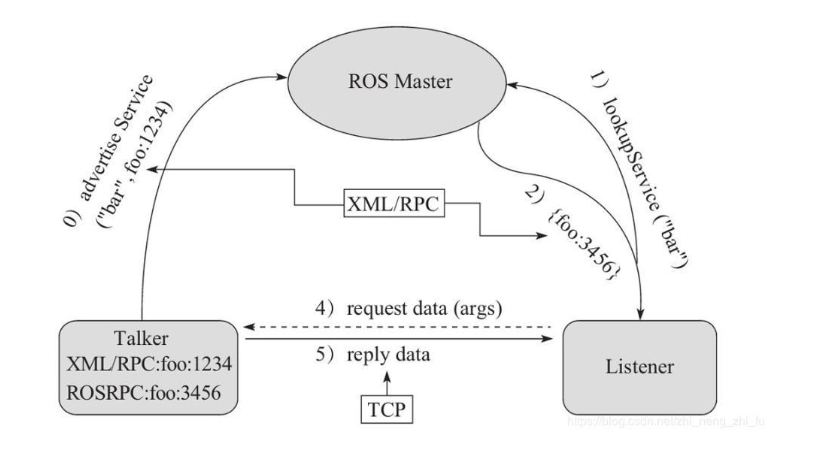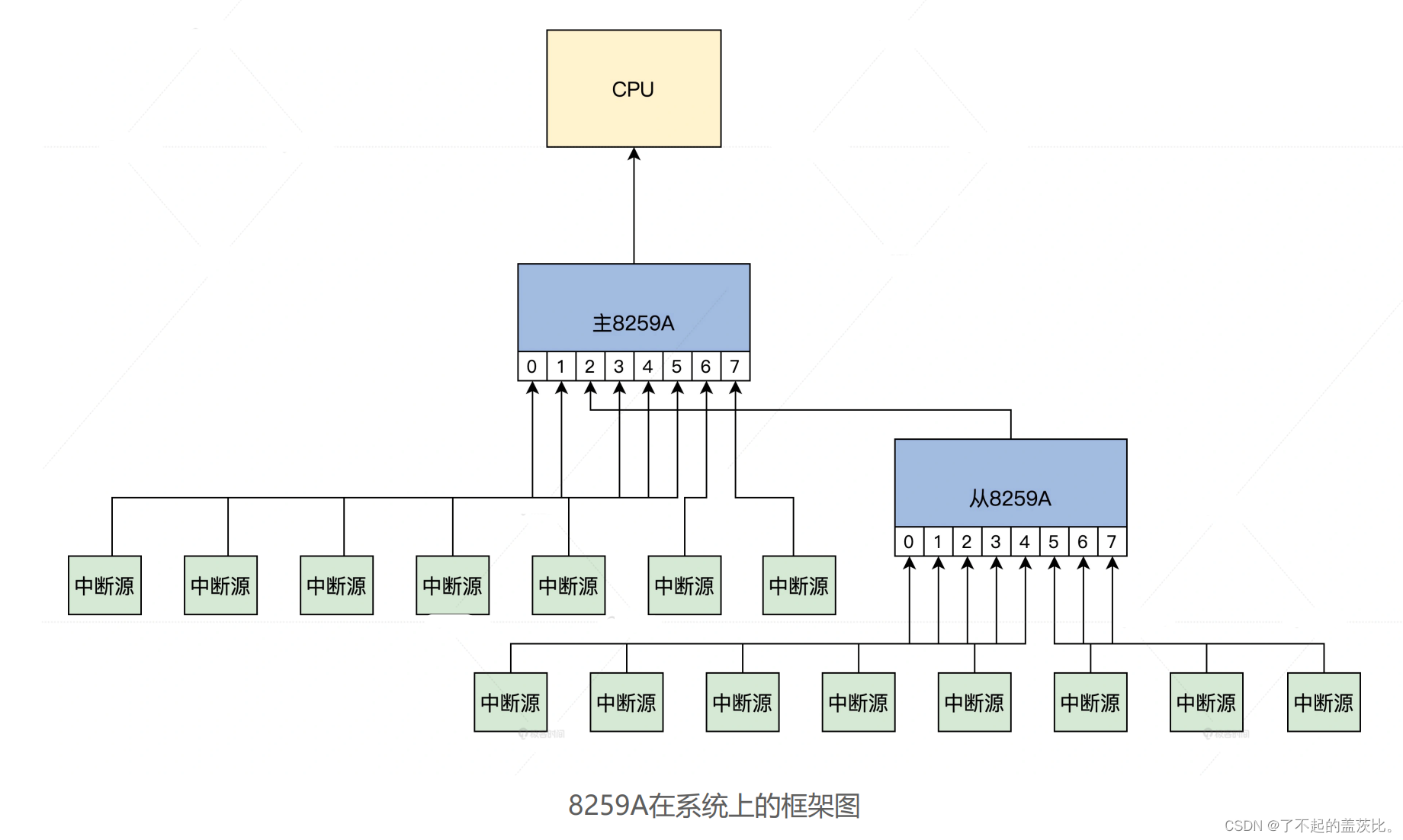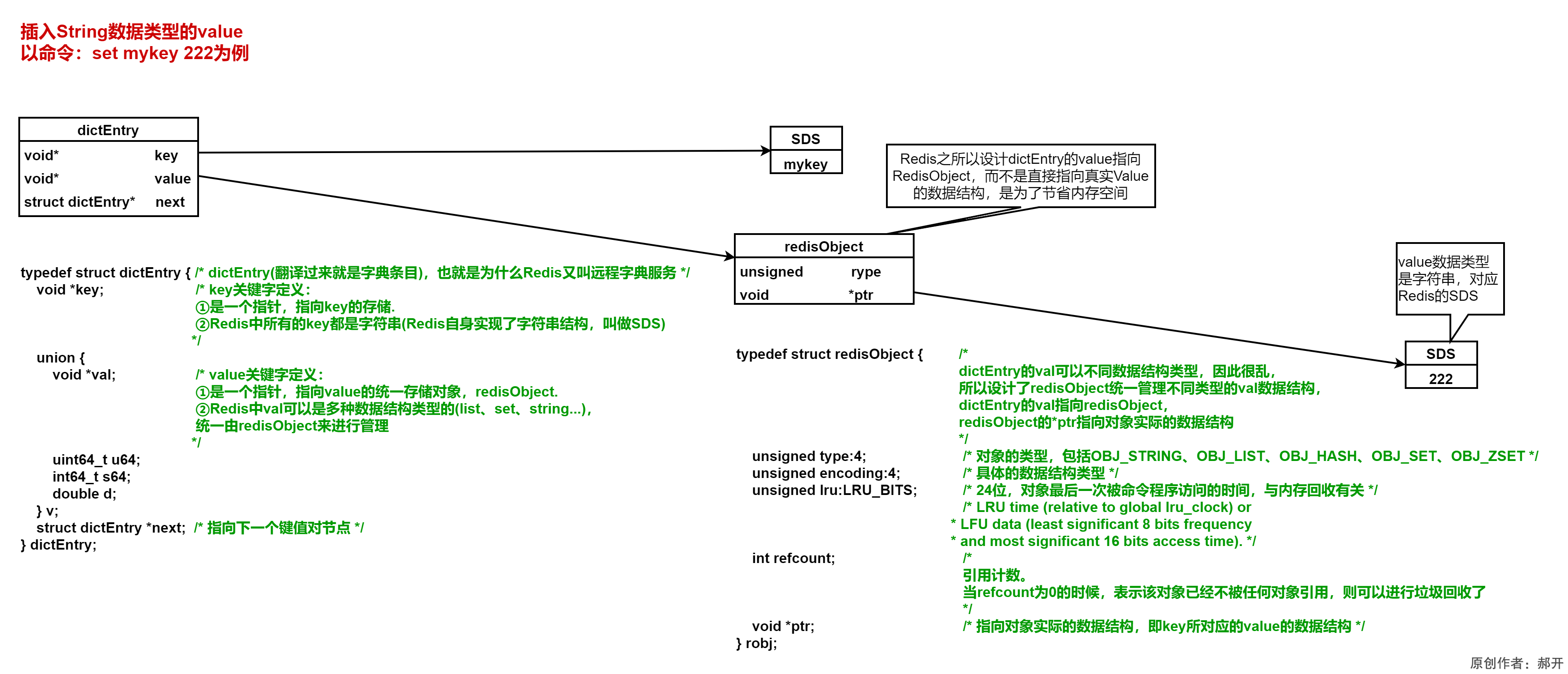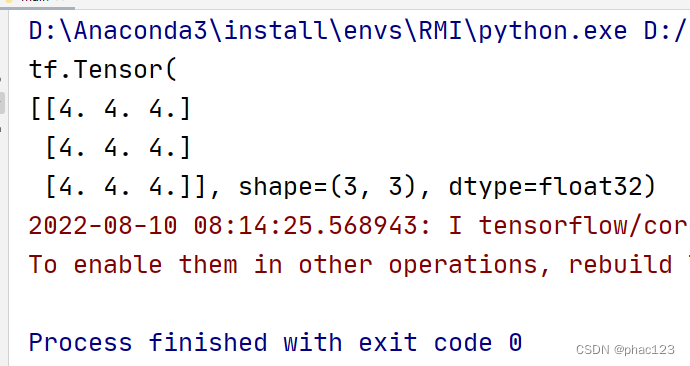当前位置:网站首页>项目2-年收入判断
项目2-年收入判断
2022-08-11 06:50:00 【一条大蟒蛇6666】
文章目录
项目2-年收入判断
友情提示
同学们可以前往课程作业区先行动手尝试!!!
项目描述
二元分类是机器学习中最基础的问题之一,在这份教学中,你将学会如何实作一个线性二元分类器,来根据人们的个人资料,判断其年收入是否高于 50,000 美元。我们将以两种方法: logistic regression 与 generative model,来达成以上目的,你可以尝试了解、分析两者的设计理念及差别。
实现二分类任务:
- 个人收入是否超过50000元?
数据集介绍
这个资料集是由UCI Machine Learning Repository 的Census-Income (KDD) Data Set 经过一些处理而得来。为了方便训练,我们移除了一些不必要的资讯,并且稍微平衡了正负两种标记的比例。事实上在训练过程中,只有 X_train、Y_train 和 X_test 这三个经过处理的档案会被使用到,train.csv 和 test.csv 这两个原始资料档则可以提供你一些额外的资讯。
- 已经去除不必要的属性。
- 已经平衡正标和负标数据之间的比例。
特征格式
- train.csv,test_no_label.csv。
- 基于文本的原始数据
- 去掉不必要的属性,平衡正负比例。
- X_train, Y_train, X_test(测试)
- train.csv中的离散特征=>在X_train中onehot编码(学历、武功状态…)
- train.csv中的连续特征 => 在X_train中保持不变(年龄、资本损失…)。
- X_train, X_test : 每一行包含一个510-dim的特征,代表一个样本。
- Y_train: label = 0 表示 “<=50K” 、 label = 1 表示 " >50K " 。
项目要求
- 请动手编写 gradient descent 实现 logistic regression
- 请动手实现概率生成模型。
- 单个代码块运行时长应低于五分钟。
- 禁止使用任何开源的代码(例如,你在GitHub上找到的决策树的实现)。
数据准备
项目数据保存在:work/data/ 目录下。
环境配置/安装
无
Logistic回归
首先我们会做 Logistic回归
数据准备
下载资料,并且对每个属性做正规化,处理过后再将其切分为训练集与验证集。
import numpy as np
import pandas as pd
X_train_fpath = 'work/data/X_train'
with open(X_train_fpath) as f:
X_train = np.array([line.strip('\n').split(',')[1:] for line in f])
print(X_train)
X_train = pd.DataFrame(X_train[1:],index=None,columns = X_train[0])
print(X_train.head())
print(X_train.shape)
[['age' ' Private' ' Self-employed-incorporated' ...
'weeks worked in year' ' 94' ' 95']
['33' '1' '0' ... ' 52' '0' '1']
['63' '1' '0' ... ' 52' '0' '1']
...
['16' '0' '0' ... ' 8' '1' '0']
['48' '1' '0' ... ' 52' '0' '1']
['48' '0' '0' ... ' 0' '0' '1']]
age Private Self-employed-incorporated State government ...
0 33 1 0 0
1 63 1 0 0
2 71 0 0 0
3 43 0 0 0
4 57 0 0 0
[5 rows x 510 columns]
(54256, 510)
import numpy as np
np.random.seed(0)
X_train_fpath = 'work/data/X_train'
Y_train_fpath = 'work/data/Y_train'
X_test_fpath = 'work/data/X_test'
output_fpath = 'work/output_{}.csv'
# 将CSV文件解析为NumPy数组
with open(X_train_fpath) as f:
next(f)
X_train = np.array([line.strip('\n').split(',')[1:] for line in f], dtype = float)
with open(Y_train_fpath) as f:
next(f)
Y_train = np.array([line.strip('\n').split(',')[1] for line in f], dtype = float)
with open(X_test_fpath) as f:
next(f)
X_test = np.array([line.strip('\n').split(',')[1:] for line in f], dtype = float)
def _normalize(X, train = True, specified_column = None, X_mean = None, X_std = None):
# 此函数用于归一化X的特定列。
# 在处理测试数据时,将重复使用训练数据的平均值和标准差。
# 参数:
# X:待处理数据。
# Train:处理训练数据时为‘True’,处理测试数据时为‘False。
# SPECIAL_COLUMN:将被规格化的列的索引。如果为‘None’,则为所有列。
# 归一化。
# X_Mean:训练数据的平均值,当Train=‘False’时使用。
# X_STD:训练数据的标准差,当Train=‘False’时使用。
# 输出:
# X:归一化数据。
# X_Mean:训练数据的计算平均值。
# X_STD:训练数据的计算标准差
if specified_column == None:
specified_column = np.arange(X.shape[1])
if train:
X_mean = np.mean(X[:, specified_column] ,0).reshape(1, -1)
X_std = np.std(X[:, specified_column], 0).reshape(1, -1)
X[:,specified_column] = (X[:, specified_column] - X_mean) / (X_std + 1e-8)
return X, X_mean, X_std
def _train_dev_split(X, Y, dev_ratio = 0.25):
# 该功能将数据分解为训练集和验证集,dev_ratio代表验证集占的比例
train_size = int(len(X) * (1 - dev_ratio))
return X[:train_size], Y[:train_size], X[train_size:], Y[train_size:]
# 使训练和测试数据标准化
X_train, X_mean, X_std = _normalize(X_train, train = True)
X_test, _, _= _normalize(X_test, train = False, specified_column = None, X_mean = X_mean, X_std = X_std)
# 将数据分解为训练集和验证集
dev_ratio = 0.1
X_train, Y_train, X_dev, Y_dev = _train_dev_split(X_train, Y_train, dev_ratio = dev_ratio)
train_size = X_train.shape[0]
dev_size = X_dev.shape[0]
test_size = X_test.shape[0]
data_dim = X_train.shape[1]
print('Size of training set: {}'.format(train_size))
print('Size of validation set: {}'.format(dev_size))
print('Size of testing set: {}'.format(test_size))
print('Dimension of data: {}'.format(data_dim))
Size of training set: 48830
Size of validation set: 5426
Size of testing set: 27622
Dimension of data: 510
一些有用的函数
这几个函数可能会在训练回圈中被重复使用到。
def _shuffle(X, Y):
# 这个函数将两个相等长度的列表/数组X和Y一起打乱
randomize = np.arange(len(X))
np.random.shuffle(randomize)
return (X[randomize], Y[randomize])
def _sigmoid(z):
# Sigmoid函数可以用来计算概率。
# 为了避免溢出,设置了最小输出值1e-8,最大输出值1 - (1e-8)。
return np.clip(1 / (1.0 + np.exp(-z)), 1e-8, 1 - (1e-8))
def _f(X, w, b):
# 这是逻辑回归函数,参数为w和b
# 参数:
# X: input data, shape = [batch_size, data_dimension]
# w: 权重向量,形状= [data_dimension,]
# b: 偏置值,标量
# 输出:
# np.matmul返回两个数组的矩阵乘积:z=x*w+b
# X:每一行被正标记的预测概率,shape = [batch_size,]
return _sigmoid(np.matmul(X, w) + b)
def _predict(X, w, b):
# 这个函数返回X每一行的真值预测
# 通过对逻辑回归函数的结果进行四舍五入。
return np.round(_f(X, w, b)).astype(np.int)
def _accuracy(Y_pred, Y_label):
# 这个函数计算预测精度
# np.abs求绝对值
acc = 1 - np.mean(np.abs(Y_pred - Y_label))
return acc
梯度与损失
def _cross_entropy_loss(y_pred, Y_label):
# 这个函数计算交叉熵。
# 输入:
# y_pred: 概率预测,浮点向量
# Y_label: 真实标签,bool向量
# 输出:
# np.dot作用是向量点积和矩阵乘法
# log下什么都不写默认是求自然对数
# cross_entropy:交叉熵,标量,cross_entropy = y真*lny预 - (1-y真)*ln(1-y预)
cross_entropy = -np.dot(Y_label, np.log(y_pred)) - np.dot((1 - Y_label), np.log(1 - y_pred))
return cross_entropy
def _gradient(X, Y_label, w, b):
# 这个函数计算相对于权重w和偏置值b的交叉熵损失梯度
# np.sum中,当axis为0时,是压缩行,即将每一列的元素相加,将矩阵压缩为一行
# 当axis为1时,是压缩列,即将每一行的元素相加,将矩阵压缩为一列
y_pred = _f(X, w, b)
pred_error = Y_label - y_pred
w_grad = -np.sum(pred_error * X.T, 1)
b_grad = -np.sum(pred_error)
return w_grad, b_grad
模型训练
一切准备就绪,开始训练吧!
我们使用小批次梯度下降法来训练。训练资料被分为许多小批次,针对每一个小批次,我们分别计算其梯度以及损失,并根据该批次来更新模型的参数。当一次回圈完成,也就是整个训练集的所有小批次都被使用过一次以后,我们将所有训练资料打散并且重新分成新的小批次,进行下一个回圈,直到事先设定的回圈数量达成为止。
# 权值和偏差的零初始化
# np.zeros((data_dim,)):得到一行全为0的列表,个数为:data_dim
w = np.zeros((data_dim,))
b = np.zeros((1,))
# 训练的一些参数
max_iter = 10
batch_size = 8
learning_rate = 0.2
# 保持每次迭代的损耗和精度,进行绘图
train_loss = []
dev_loss = []
train_acc = []
dev_acc = []
# 计算参数更新的次数
step = 1
# 迭代训练
for epoch in range(max_iter):
# 在每轮的迭代中随机打乱训练集X_train和验证集Y_train
X_train, Y_train = _shuffle(X_train, Y_train)
# 小批次训练,用于以元素方式返回输入的下限。
for idx in range(int(np.floor(train_size / batch_size))):
X = X_train[idx*batch_size:(idx+1)*batch_size]
Y = Y_train[idx*batch_size:(idx+1)*batch_size]
# 计算梯度
w_grad, b_grad = _gradient(X, Y, w, b)
# 梯度下降更新
# 学习率随时间衰减
w = w - learning_rate/np.sqrt(step) * w_grad
b = b - learning_rate/np.sqrt(step) * b_grad
step = step + 1
# 计算训练集和验证集的损耗和精度
y_train_pred = _f(X_train, w, b)
Y_train_pred = np.round(y_train_pred)
train_acc.append(_accuracy(Y_train_pred, Y_train))
train_loss.append(_cross_entropy_loss(y_train_pred, Y_train) / train_size)
y_dev_pred = _f(X_dev, w, b)
Y_dev_pred = np.round(y_dev_pred)
dev_acc.append(_accuracy(Y_dev_pred, Y_dev))
dev_loss.append(_cross_entropy_loss(y_dev_pred, Y_dev) / dev_size)
print('Training loss: {}'.format(train_loss[-1]))
print('validation loss: {}'.format(dev_loss[-1]))
print('Training accuracy: {}'.format(train_acc[-1]))
print('validation accuracy: {}'.format(dev_acc[-1]))
Training loss: 0.271355435246406
validation loss: 0.28963596750262866
Training accuracy: 0.8836166291214418
validation accuracy: 0.8733873940287504
绘制损失和精度曲线
%matplotlib inline
import matplotlib.pyplot as plt
# 损失曲线
plt.plot(train_loss)
plt.plot(dev_loss)
plt.title('Loss')
plt.legend(['train', 'dev'])
plt.savefig('loss.png')
plt.show()
# 精度曲线
plt.plot(train_acc)
plt.plot(dev_acc)
plt.title('Accuracy')
plt.legend(['train', 'dev'])
plt.savefig('acc.png')
plt.show()

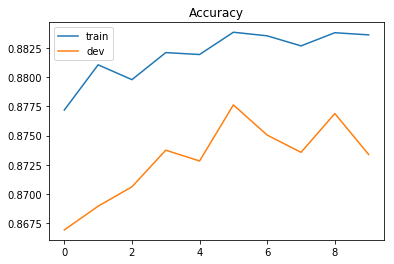
预测测试标签
预测测试集的资料标签并且存在 output_logistic.csv 中。
# 预测测试集标签
predictions = _predict(X_test, w, b)
with open(output_fpath.format('logistic'), 'w') as f:
f.write('id,label\n')
for i, label in enumerate(predictions):
f.write('{},{}\n'.format(i, label))
# 打印出最重要的10个权重w
# np.argsort返回的是元素值从小到大排序后的索引值的数组
# [::-1]将数组倒序
ind = np.argsort(np.abs(w))[::-1]
with open(X_test_fpath) as f:
content = f.readline().strip('\n').split(',')
features = np.array(content)
for i in ind[0:10]:
print(features[i], w[i])
Not in universe -4.031960278019252
Spouse of householder -1.6254039587051405
Other Rel <18 never married RP of subfamily -1.4195759775765409
Child 18+ ever marr Not in a subfamily -1.2958572076664745
Unemployed full-time 1.1712558285885908
Other Rel <18 ever marr RP of subfamily -1.1677918072962366
Italy -1.0934581438006177
Vietnam -1.0630365633146412
num persons worked for employer 0.9389922773566517
1 0.822661492211719
多变量生成模型
接着我们将实作基于 generative model 的二元分类器。
数据准备
训练集与测试集的处理方法跟 logistic regression 一模一样,然而因为 generative model 有可解析的最佳解,因此不必使用到验证集。
# 将CSV文件解析为NumPy数组
with open(X_train_fpath) as f:
next(f)
X_train = np.array([line.strip('\n').split(',')[1:] for line in f], dtype = float)
with open(Y_train_fpath) as f:
next(f)
Y_train = np.array([line.strip('\n').split(',')[1] for line in f], dtype = float)
with open(X_test_fpath) as f:
next(f)
X_test = np.array([line.strip('\n').split(',')[1:] for line in f], dtype = float)
# 归一化
X_train, X_mean, X_std = _normalize(X_train, train = True)
X_test, _, _= _normalize(X_test, train = False, specified_column = None, X_mean = X_mean, X_std = X_std)
平均值和协方差
在 generative model 中,我们需要分别计算两个类别内的资料平均与共变异。
# 计算类内平均值
X_train_0 = np.array([x for x, y in zip(X_train, Y_train) if y == 0])
X_train_1 = np.array([x for x, y in zip(X_train, Y_train) if y == 1])
mean_0 = np.mean(X_train_0, axis = 0)
mean_1 = np.mean(X_train_1, axis = 0)
# 计算类内协方差
cov_0 = np.zeros((data_dim, data_dim))
cov_1 = np.zeros((data_dim, data_dim))
for x in X_train_0:
cov_0 += np.dot(np.transpose([x - mean_0]), [x - mean_0]) / X_train_0.shape[0]
for x in X_train_1:
cov_1 += np.dot(np.transpose([x - mean_1]), [x - mean_1]) / X_train_1.shape[0]
# 共享协方差是单个类内协方差的加权平均值。
cov = (cov_0 * X_train_0.shape[0] + cov_1 * X_train_1.shape[0]) / (X_train_0.shape[0] + X_train_1.shape[0])
计算权重和偏差
权重矩阵与偏差向量可以直接被计算出来。
# 计算协方差矩阵的逆矩阵。
# 由于协方差矩阵可能近乎奇异,np.linalg.inv()可能会给出较大的数值误差。
# 通过SVD分解,可以高效准确地得到矩阵的逆。
u, s, v = np.linalg.svd(cov, full_matrices=False)
inv = np.matmul(v.T * 1 / s, u.T)
# 直接计算权重w和偏差b
w = np.dot(inv, mean_0 - mean_1)
b = (-0.5) * np.dot(mean_0, np.dot(inv, mean_0)) + 0.5 * np.dot(mean_1, np.dot(inv, mean_1))\
+ np.log(float(X_train_0.shape[0]) / X_train_1.shape[0])
# 计算训练集的准确度
Y_train_pred = 1 - _predict(X_train, w, b)
print('Training accuracy: {}'.format(_accuracy(Y_train_pred, Y_train)))
Training accuracy: 0.8671114715423179
预测测试标签
预测测试集的资料标签并且存在 output_generative.csv 中。
# 预测测试集标签
predictions = 1 - _predict(X_test, w, b)
with open(output_fpath.format('generative'), 'w') as f:
f.write('id,label\n')
for i, label in enumerate(predictions):
f.write('{},{}\n'.format(i, label))
# 打印出最重要的10个权重w
ind = np.argsort(np.abs(w))[::-1]
with open(X_test_fpath) as f:
content = f.readline().strip('\n').split(',')
features = np.array(content)
for i in ind[0:10]:
print(features[i], w[i])
Retail trade 7.67333984375
Midwest -6.3125
34 -5.835205078125
37 -5.489013671875
Child <18 ever marr not in subfamily -5.4759521484375
Other service -5.00390625
Different county same state 4.66796875
33 -3.91015625
Private household services 3.8623046875
32 -3.51953125
边栏推荐
- Amazon API interface Daquan
- matplotlib
- 基于FPGA的FIR滤波器的实现(4)— 串行结构FIR滤波器的FPGA代码实现
- Douyin share password url API tool
- concept noun
- 从何跟踪伦敦金最新行情走势?
- MindManager2022全新正式免费思维导图更新
- Redis + lua implements distributed interface current limiting implementation scheme
- 博途PLC 1200/1500PLC ModbusTcp通信梯形图优化汇总(多服务器多从站轮询)
- Douyin get douyin share password url API return value description
猜你喜欢
随机推荐
如何选择专业、安全、高性能的远程控制软件
easyrecovery15数据恢复软件收费吗?功能强大吗?
软件测试主要做什么工作,难不难?
A used in the study of EEG ultra scanning analysis process
进制转换间的那点事
Douyin API interface
jar服务导致cpu飙升问题-带解决方法
Daily sql-employee bonus filtering and answer rate ranking first
Coordinate system in navigation and positioning
从何跟踪伦敦金最新行情走势?
【LaTex-错误和异常】\verb ended by end of line.原因是因为闭合边界符没有在\verb命令所属行中出现;\verb命令的正确和错误用法、verbatim环境的用法
exness:黄金1800关口遇阻,静待美国CPI出炉
Daily sql-statistics of the number of professionals (including the number of professionals is 0)
2022年中国软饮料市场洞察
Taobao product details API interface
年薪40W测试工程师成长之路,你在哪个阶段?
MySQL使用GROUP BY 分组查询时,SELECT 查询字段包含非分组字段
redis操作
Pico neo3 Unity打包设置
那些事情是用Unity开发项目应该一开始规划好的?如何避免后期酿成巨坑?




